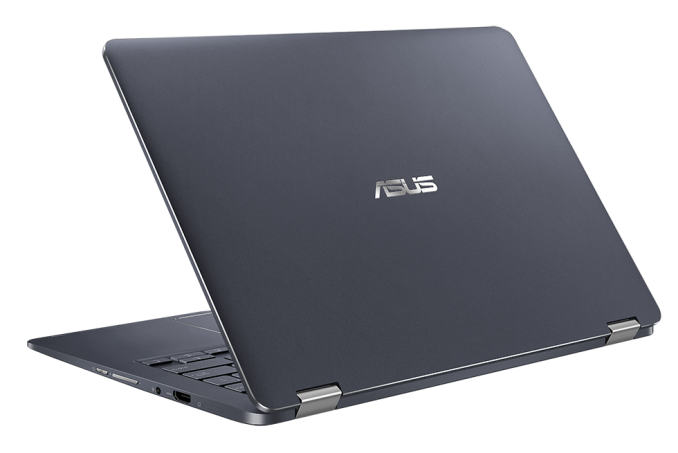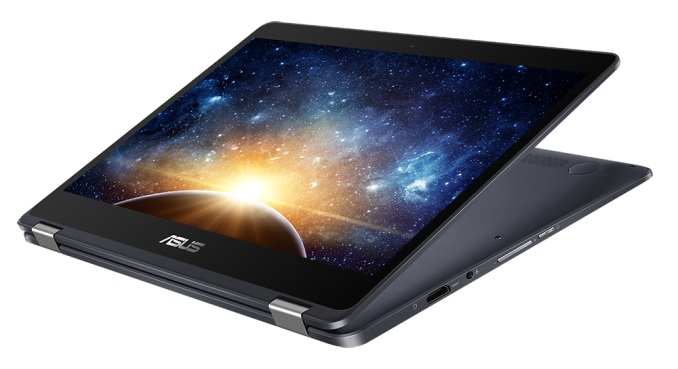ASUS Announces the NovaGo (TP370): A Snapdragon 835 based Windows 10 PC
by Ian Cutress on December 5, 2017 3:55 PM EST- Posted in
- Laptops
- Snapdragon
- Asus
- Qualcomm
- Notebooks
- Windows 10 S
- SD835

At the Qualcomm Snapdragon Technology Summit today, alongside Qualcomm officially announcing the Snapdragon 835 Mobile PC platform, several partners got up on stage to promote their upcoming wares. The main headline device was from ASUS. CEO Jerry Shen announced the ASUS NovaGo (TP370) as the world’s first Gigabit LTE capable laptop, supported by the SD835 chip and its inbuilt X16 LTE modem.
The key factor of these devices that ASUS (and Qualcomm) want to drive home is the always-on connectivity (provided by the built-in modem) as well as the battery life. To that end ASUS is listing the new NovaGo as having up to 22 hours of battery life and 30 days of modern standby. The idea is that the user can pick up the notebook in the morning and not need to charge it all day until they get home, or in the case of one speaker’s experience, charge it once a week. The battery is rated at 52 Wh.
On the connectivity front, ASUS has bundled the X16 LTE modem with enough hardware support for 4x Carrier Aggregation and 4x4 MIMO for up to gigabit LTE speeds, and 2x2 802.11ac for standard wireless connectivity. The LTE data flow can be accessed by eSIM or nanoSIM, allowing users to activate local data plans from the Windows Store immediately coming off the plane.
The base specifications have the device at 4GB DRAM and 64GB of UFS 2.0 storage, or there will be an upgraded model with 8GB of DRAM and 128GB of storage for an extra $200. ASUS lists the storage as capable of 1.4 Gbps, although it will be interesting to see how that translates when we get the devices on hand. Ports on the NovaGo include two USB 3.1 (5 Gbps) Type-A ports and an HDMI port, with a 3.5mm jack.
| ASUS NovaGo (TP370) | |||
| Specifications | |||
| SoC | Qualcomm Snapdragon 835 Mobile SoC 4 x Kryo 280 Performance (2.45 GHz) 4 x Kryo Efficiency (1.9 GHz) Adreno 540 GPU (710 MHz) |
||
| Operating System | Microsoft Windows 10 S | ||
| Display | 13.3-inch 1920x1080 IPS | ||
| DRAM | 4 GB | 8 GB | |
| Storage | 64 GB | 128 GB | 256 GB |
| Connectivity | Qualcomm Integrated X16 LTE Cat 16 Download: 1 Gbps Cat 13 Upload: 150 Mbps 2x2 802.11ac MU-MIMO Wi-Fi |
||
| I/O | 2 x USB 3.1 (5 Gbps) Type-A 1 x 3.5mm Audio Jack 1 x Combo Nano-SIM (tray) 1 x MicroSD Card Reader (up to 256 GB) 1 x HDMI 1 x DX-in |
||
| Speakers | 2 x Stereo with Smart Amp | ||
| Battery | 52 Wh Li-Po | ||
| Dimensions | 316.0 x 221.6 x 14.9 mm 1.39 kg |
||
| Price (US MSRP) | $599 | $799 | ? |
The OS will be Windows 10 S. This runs a version of Windows that relies mostly on the Store for the main applications but the system does perform binary translation (or similar) for 32-bit x86 applications. 64-bit x86 apps are a no-go, so for users that have their own software setups outside the Windows 10 store, it might get a little tricky (Qualcomm doesn’t see this as much of an issue). Applications like Office365 will have their own optimized versions for the SD835 Mobile PC devices.
The NovaGo is a full 360º hinge design, with a 14.9mm z-height and weighing in at 1.39 kg with a sandblasted Sky Grey finish. The 13.3-inch 1080p NanoEdge display has a 78% screen to body ratio and supports 10-point multitouch as well as ASUS Pen support with 1024 pressure levels. ASUS also cites 178º viewing angles and 100% sRGB gamut, with ASUS Eye Care and Tru2Life video technology.
Arrangements are already in place with T-Mobile, Sprint, Verizon, TIM, China Telecom and Chunghwa Telecom, while other providers in the main first wave of countries (US, UK, Italy, France, Germany, China, Taiwan) are in discussions with ASUS.
Pricing for the device gives the base 4/64 model as $599, and the upgraded 8/128 model as $799. That puts it in the realm of a large number of good Intel-based clamshells, including those from ASUS, although without always-on connectivity.
Availability will be region dependant, though we did not get any other information. ASUS say they are the first, and with a bunch of devices coming at CES, it would be before the others (HP says Spring 2018).












36 Comments
View All Comments
Diji1 - Wednesday, December 6, 2017 - link
What? Why wouldn't someone else just integrate a gig modem somewhere else other than the CPU if they wanted it?thecoolnamesweretaken - Tuesday, December 5, 2017 - link
I'm currently using a Lenovo Yoga Book running Windows Pro 64-bit on the last Intel Atom Cherry Trail 2W TDP quad core CPU (x5-z8550) with integrated LTE, 1920x1200 IPS touch panel and a footprint of 690 grams.Intel discontinued the successors to the Cherry Trail line so I've been wondering what Lenovo would replace it with.
I think Asus' new offering is probably pointing a way for Lenovo to follow although the hinges on that NovaGo don't seem as 360-resistant as the watchband hinge Lenovo crafted.
I'm interested to hear what kind of IPC you get out of emulating x86-32 on a Snapdragon 835 and whether it's power efficient compared with the x5-8550 (which runs x64 Windows applications natively).
cfenton - Tuesday, December 5, 2017 - link
"The OS will be Windows 10 S. This runs a version of Windows that relies mostly on the Store for the main applications but the system does perform binary translation (or similar) for 32-bit x86 applications. 64-bit x86 apps are a no-go, so for users that have their own software setups outside the Windows 10 store, it might get a little tricky (Qualcomm doesn’t see this as much of an issue)."Qualcomm is wrong. The Windows Store is a garbage fire. No Firefox, no Chrome, no Google Drive, no Brave, no Plex server, etc. Some of those applications might still have 32 bit versions, but they aren't going to be the focus for future development when almost every computer sold in the past decade has 64 bit support. That's also assuming the x86 emulator (or whatever) runs at a decent speed.
damianrobertjones - Wednesday, December 6, 2017 - link
You're only thinking about 'you' and not beyond 'you'.Firefox, Chrome, Google Drive (Onedrive is there), Brave and plex... Ask my Step Father if he uses ANY of those and the answer will be no. He needs Microsoft Word, the web and that's about it.
cfenton - Wednesday, December 6, 2017 - link
I don't doubt there are people who use none of those applications. However, those are all very common applications (except Brave), especially Chrome and Firefox. Your stepfather would be fine with a $400 laptop with an i3 and full Windows. Why spend $600+ for this one?ikjadoon - Wednesday, December 6, 2017 - link
22 hours of battery life. Built-in LTE. An 1080p IPS screen. A good keyboard/trackpad. Decent build quality that won't creak because you're holding it. Are you blind to everything else that makes a laptop worth having...besides the motherboard inside? Step outside of the Anandtech bubble. It's scary, but we're real people out here, too.You all keep running to the hills with "Muh IPC and emulayshunnn." Chill--most consumers, especially those buying sub-$1000 laptops, don't use laptops like you. They do want much longer battery life. They do like instant-on. They do like IPS screens. They do like decent keyboards/trackpads.
And, you're insulting his stepfather by asking him to use a $400 Intel/AMD laptop. Those are bottom-of-the-barrel CPUs trying to run full-fat x86-64 Windows. It's almost always a terrible compromise in software and hardware; it's ugly, useless compromises everywhere. I know; I've bought six laptops for friends and family on a tight budget over the past year.
There is shit. Everywhere. Smeared along every website. TN 768p screens! 5400PM hard drives! Crazy keyboard layouts with no travel! Touchpads from the 2000s. Build quality from the 1990s! Battery life no better than Memrom from 2008!
It's all shit. This is 13" of IPS + SSD + 20 hours of battery life + decent keyboard/track + decent build quality + touchscreen.
How are y'all so blind to this value proposition?....
negusp - Wednesday, December 6, 2017 - link
This is far from being a good value. For $500 I can pick up a Skylake i5 with an SSD and an IPS screen. 2 FUCKING YEARS ago I picked up my HP x360 with a 6200U, IPS touchscreen, and IPS LCD for $549.Though battery life will be a major boon on ARM the prices are insane for a beta product.
cfenton - Thursday, December 7, 2017 - link
I specifically picked $400 because that's around the price for entry level i3s (still faster than an 835) and 128GB ssds. Step it up to $600-$800 like this thing costs and as negusp says, you can get a pretty good ultrabook. You're right that there is a bunch of cheap crap out there, but this thing is priced to high to address that market.I can't argue with the battery life. That's a real distinguishing feature. If, for whatever reason, you're regularly away from an outlet for more than 10 hours, this may be the perfect laptop.
I'm extremely skeptical about a regular user buying an additional data plan to use with their laptop, especially given how fast a laptop would chew through data. It's certainly a benefit for some, but not regular users. I'd just tether my laptop to my phone.
Wlkn - Tuesday, December 5, 2017 - link
No USB c to charge? Can't tell from photos, only one side is shown. USB C all the thingswr3zzz - Tuesday, December 5, 2017 - link
$799 for a glorified Chrome Book is not a good value proposition.